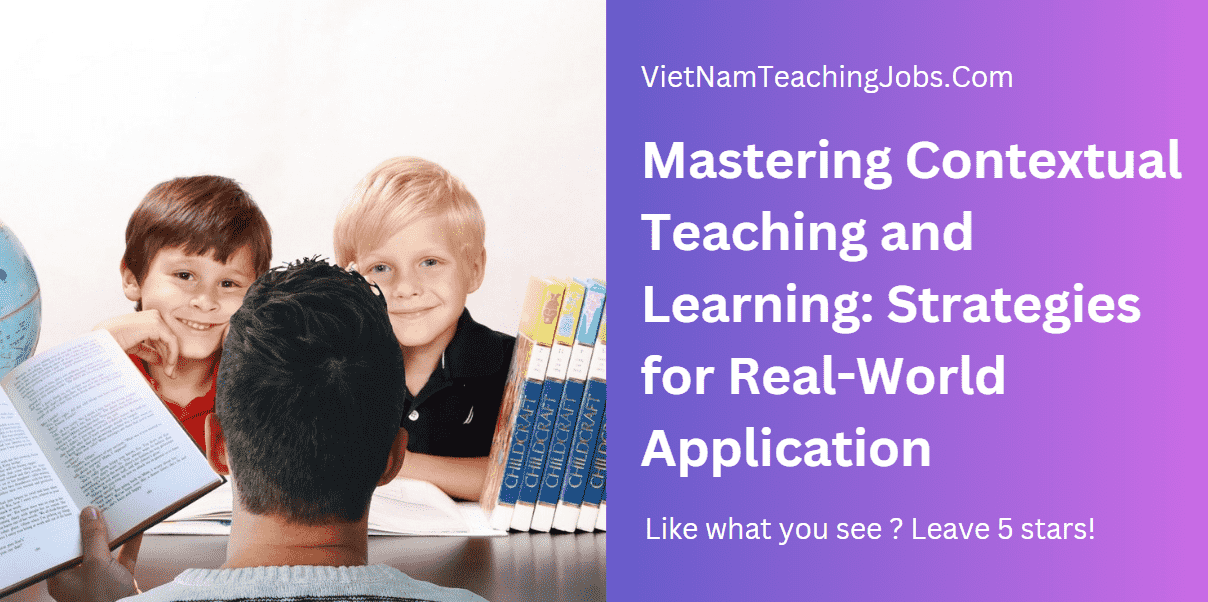In the dynamic landscape of education, the pursuit of effective teaching methodologies has evolved beyond the traditional boundaries. One paradigm that has gained significant recognition for its transformative impact is “culturally responsive teaching”. This approach not only acknowledges the rich tapestry of diversity within classrooms but also embraces it as a cornerstone of effective education. In this comprehensive guide, VTJ will delve into the essence of Culturally Responsive Teaching, explore the fundamental principles that underpin it, and provide a plethora of strategies and examples to seamlessly integrate this approach into your educational practices.
>>>Read more: Active vs. Passive Learning: Which One to Use?
>>>Read more: Lesson Objectives (Learning Objectives): How to Write in 4 Steps
What Is Culturally Responsive Teaching?

What Is Culturally Responsive Teaching? Culturally Responsive Teaching integrate students’ cultural backgrounds into the learning process
Culturally Responsive Teaching (CRT) is an educational approach that recognizes the significance of integrating students’ cultural backgrounds into the learning process. This approach acknowledges that students’ identities, experiences, and perspectives are essential components of their education. By valuing and incorporating diverse cultural elements, CRT aims to establish an inclusive and equitable educational environment.
>>>Read more: Project-based learning (PBL): Benefits, Examples & Ideas
One of the foundational principles of culturally responsive teaching is the cultivation of cultural awareness and sensitivity among educators. This involves educators actively examining their own biases and assumptions, thus enabling them to better understand and appreciate the cultural nuances of their students. This self-awareness forms the basis for fostering respectful interactions and building strong relationships within the classroom. By embracing the cultural backgrounds of their students, teachers can create an atmosphere that celebrates diversity and enriches the educational experience.
>>>Read more: Formative and Summative Assessment: What’s the Difference?
Requirements For Creating A Culturally Responsive Classroom

Requirements For Creating A Culturally Responsive Classroom
Creating a culturally-responsive classroom requires a deliberate and thoughtful approach that takes into account the diverse backgrounds and experiences of students. Several key requirements serve as the foundation for establishing an inclusive and effective learning environment.
>>>Read more: Teacher Leadership: 5 Essential Teacher Leadership Skills
Establish inclusion
Inclusion lies at the heart of a culturally-responsive classroom. Educators must actively work to ensure that all students feel valued and respected, regardless of their cultural heritage. This involves creating a physical and emotional space where every student’s identity is acknowledged and celebrated. Teachers can achieve this by displaying culturally diverse materials, celebrating various cultural holidays, and incorporating inclusive language in their interactions. By establishing a sense of belonging for all students, the classroom becomes a safe space for sharing diverse perspectives and engaging in open discussions.
>>>Read more: 6 Types of Assessment in Education & How to Use Them
Develop positive attitudes
Promoting positive attitudes towards cultural diversity is essential in fostering a culturally-responsive classroom. Educators should encourage an atmosphere where curiosity and appreciation for different cultures are nurtured. Teachers can achieve this by facilitating meaningful conversations about cultural differences, addressing stereotypes and biases, and encouraging students to share their cultural backgrounds. By actively challenging negative preconceptions and promoting understanding, educators help create an environment where diversity is seen as an asset that enriches the learning experience.
>>>Read more: How to Deal with Difficult Parents: 10 Best Strategies
Enhance meaning
Culturally-responsive teaching aims to connect curriculum content to students’ lived experiences. To achieve this, educators should seek ways to make lessons more relevant and relatable. This involves integrating culturally diverse examples, case studies, and real-world applications into the curriculum. By linking academic content to students’ cultural contexts, educators enable students to see the practical significance of what they’re learning. This approach not only deepens understanding but also reinforces the idea that their cultural identities are valued components of the learning process.
>>>Read more: Leadership Styles in Education: 8 Effective Ways to Lead
Foster confidence
Culturally-responsive classrooms empower students to embrace their cultural backgrounds with confidence. Teachers play a pivotal role in boosting students’ self-esteem by validating their identities and recognizing their contributions. Assignments and activities that allow students to share their cultural knowledge, traditions, and stories can help build a sense of pride and self-assurance. Moreover, educators should create opportunities for students to lead discussions on cultural topics, fostering leadership skills and enhancing overall classroom dynamics.
>>>Read more: Meaningful Feedback for Students: Importance, Tips and Examples
Benefits of Culturally Responsive Teaching

Culturally Responsive Teaching (CRT) strategies offer a wide range of benefits for both students and educators
Culturally Responsive Teaching (CRT) offers a wide range of benefits for both students and educators, enriching the learning experience and promoting a more inclusive and equitable educational environment. Here are some of the key benefits:
- Enhanced Engagement and Motivation: When students see their own cultural backgrounds and experiences reflected in the curriculum, they are more likely to be engaged and motivated in their learning. CRT taps into their interests and identities, making the learning experience more meaningful and relevant.
- Improved Academic Achievement: Culturally responsive teaching recognizes and builds upon students’ prior knowledge and experiences, which can lead to improved academic achievement. By connecting new concepts to what students already know, they can better grasp and retain information.
- Positive Identity Development: CRT helps students develop a positive sense of identity and self-esteem. When their cultural backgrounds are acknowledged and valued in the classroom, students feel a sense of belonging and pride in who they are, which positively impacts their overall well-being.
- Reduced Stereotyping and Bias: Culturally responsive teaching challenges stereotypes and biases by presenting accurate and respectful representations of various cultures. This helps students develop a more nuanced and critical understanding of different groups of people.
- Preparation for a Diverse Society: As societies become increasingly diverse, students who have been exposed to culturally responsive teaching are better prepared to navigate and contribute to a multicultural world. They develop skills that are valuable for effective communication, collaboration, and problem-solving in diverse contexts.
>>>Read more: What is Active Listening Skills: Types, Techniques & Examples
Culturally Responsive Teaching Strategies And Examples

Culturally Responsive Teaching Strategies And Examples
Creating a truly culturally responsive classroom involves a thoughtful and deliberate approach that incorporates a range of strategies aimed at valuing and integrating the cultural backgrounds and experiences of students. These strategies not only enhance engagement and understanding but also create a sense of inclusivity and belonging. Here, we’ll delve into each strategy, providing in-depth explanations and examples:
Learn about your students
To effectively implement culturally responsive teaching, it’s essential to know your students on a personal level. Take the time to understand their cultural backgrounds, interests, and learning styles. This knowledge can be gained through surveys, discussions, and even informal conversations. For example, learning that a significant portion of your class celebrates a particular cultural holiday can prompt you to incorporate related content or activities into your lessons.
>>>Read more: What is Independent Learning and How It Works: A teacher’s guide
Interview students
Conducting individual interviews with students can provide deeper insights into their cultural identities, strengths, and learning preferences. Through open-ended conversations, you can learn about their family backgrounds, hobbies, and any cultural traditions they hold dear. Armed with this information, you can design lessons that resonate with their experiences and perspectives.
>>>Read more: 13 Types of Students in the Classroom and How to Deal with Them
Integrate relevant word problems
Mathematics and problem-solving offer an opportunity to infuse cultural relevance. Develop word problems that draw from a variety of cultural contexts. For instance, when teaching fractions, create scenarios involving cooking recipes from diverse cultures, showcasing how fractions are applied in real-life situations that resonate with students’ backgrounds.
>>>Read more: What Is Inquiry-Based Learning (IBL)? Types, Benefits & How to Use
Present new concepts by using student vocabulary
When introducing new concepts, make an effort to use vocabulary and examples that are familiar to your students. By relating concepts to their everyday lives, you can bridge the gap between abstract ideas and concrete experiences. For instance, when explaining scientific principles, incorporate examples from students’ communities or cultural contexts to make the content more relatable.
>>>Read more: How to Teach Writing Skills to Students Effectively in 8 Simple Steps
Bring in guest speakers
Inviting guest speakers from different cultural backgrounds to share their experiences can be enriching for students. These speakers can offer unique insights into their cultures, personal journeys, and perspectives. Such interactions foster a deeper understanding of diversity and promote open dialogues about cultural topics.
>>>Read more: 10+ Strategies of How to Teach Reading Comprehension in the Class
Deliver different forms of content through learning stations
Students have diverse learning styles and preferences. To accommodate these differences, create learning stations that offer content through various formats. This could include videos, texts, interactive technology, hands-on activities, and artistic projects. By appealing to different modes of learning, you can ensure that all students can engage meaningfully with the material.
>>>Read more: 5 Types of Teaching Styles (Their Pros & Cons)
Gamify lessons
Gamification can inject an element of fun and engagement into lessons while incorporating cultural themes. Design educational games or activities that revolve around cultural trivia, historical events, or famous figures from various backgrounds. This approach encourages active participation and fosters a sense of competition that can make learning more enjoyable.
>>>Read more: Why Students Get Bored & How to Engage Bored Students in the Class
Call on each student
Incorporate an inclusive participation strategy by ensuring that each student has an opportunity to contribute to class discussions. This practice sends the message that every voice is valued and creates an environment where diverse perspectives are heard and appreciated.
>>>Read more: 21+ Best Classroom Management Books for Teachers
Use media that positively depict a range of cultures
Select reading materials, films, artwork, and other media that portray a variety of cultures in a respectful and positive manner. By presenting accurate and diverse representations, you can challenge stereotypes and broaden students’ understanding of different cultures.
>>>Read more: 22+ SMART Teacher Goals Examples in 2023
Offer different types of free study time
Recognize that students have different preferences for how they study and learn best. Provide options for free study time that accommodate these differences. Some students might thrive in collaborative group study sessions, while others might prefer quiet individual study. This flexibility allows each student to tailor their learning experience.
>>>Read more: How to Teach Critical Thinking Skills to Students
Encourage students to propose ideas for projects
Empower students by involving them in shaping their learning experiences. Encourage them to propose project ideas that reflect their interests and cultural backgrounds. This approach not only allows students to take ownership of their education but also ensures that the curriculum resonates with their lived experiences.
>>>Read more: Guide on How to Teach Vocabulary Effectively for Teachers
Experiment with peer teaching
Peer teaching is a powerful strategy that allows students to share their knowledge and perspectives with their peers. Encourage students to take turns teaching a concept to the class. This approach not only exposes students to diverse teaching styles but also promotes collaboration and mutual learning.
>>>Read more: 120+ High and Middle School Debate Topics for Students
Establish cooperative base groups
Creating small cooperative groups with diverse members can foster collaboration and understanding. These groups can work together on projects or assignments, providing opportunities for students to learn from each other’s viewpoints and experiences.
>>>Read more: How To Write a Curriculum in 8 Steps: A Complete Guide
Run problem-based learning scenarios
Problem-based learning involves presenting students with real-world problems that require critical thinking and collaboration to solve. Design scenarios that are culturally diverse, encouraging students to consider multiple perspectives and solutions. This approach develops both problem-solving skills and cultural competency.
>>>Read more: 4 Types of Learning Styles: How to Use VARK Model in Teaching
Involve parents by using take-home letters
Engaging parents in the culturally responsive classroom can be achieved through take-home letters. These letters can inform parents about classroom activities, projects, and discussions related to cultural topics. Additionally, they can provide suggestions for ways parents can support their child’s learning by sharing cultural stories, traditions, or experiences.
>>>Read more: How To Write a Lesson Plan in 6 Steps: The Complete Guide
Cultivating a culturally responsive classroom is a transformative approach that goes beyond traditional teaching methods. By implementing a variety of strategies that honor and integrate the cultural backgrounds and experiences of students, educators can create a learning environment that is inclusive, engaging, and meaningful. Culturally responsive teaching is a cornerstone of building an equitable educational system that celebrates diversity and prepares students for success in an increasingly interconnected world.
FAQs
What are the 7 principles of culturally responsive teaching?
The 7 principles include: affirming cultural competence, incorporating cultural content, developing a sociopolitical consciousness, creating a culturally inclusive classroom environment, involving families and communities, adapting to student needs, and assessing cultural competence.
What are the 4 characteristics of culturally responsive teaching?
The 4 characteristics are: academic success through cultural competence, a student-centered approach, a critical consciousness that challenges social inequalities, and a focus on the holistic development of students.
Are you facing difficulties in finding and securing teaching positions in Vietnam? Are visa procedures causing you trouble? Feeling overwhelmed and directionless upon your arrival in Vietnam for teaching assignments? Don’t worry, VTJ’s English Teaching Placement in Vietnam (EPIV) Program 2024 provides comprehensive support to solve ALL the matters.
👉👉👉 Click HERE to request free consultation




